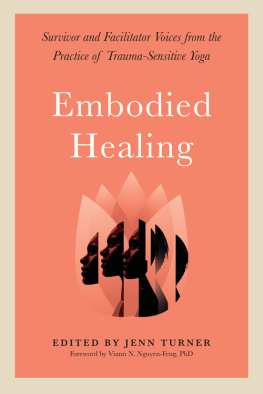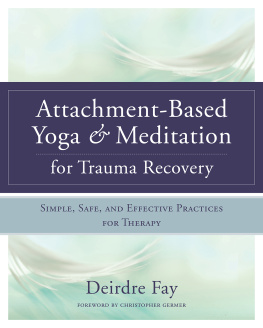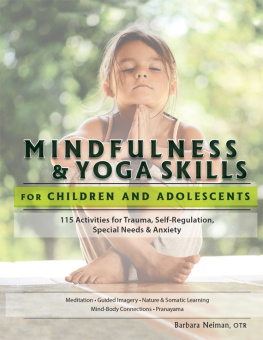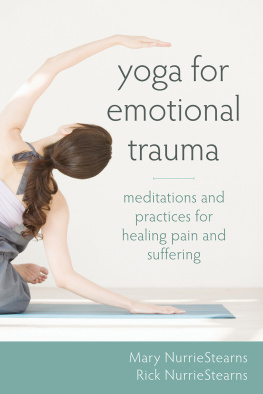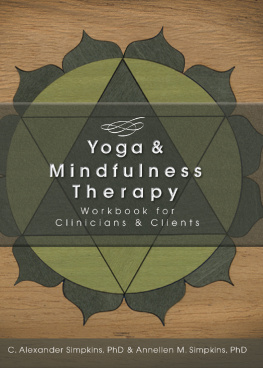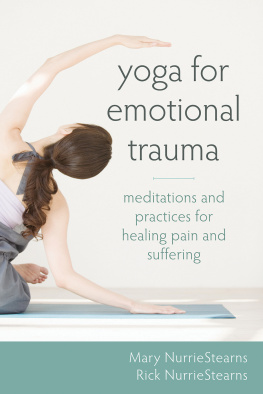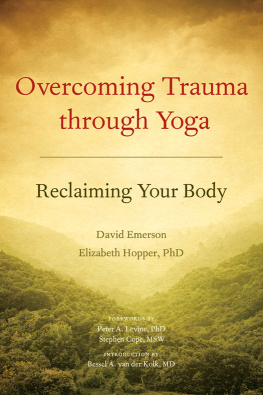Emerson - Trauma-sensitive yoga in therapy: bringing the body into treatment
Here you can read online Emerson - Trauma-sensitive yoga in therapy: bringing the body into treatment full text of the book (entire story) in english for free. Download pdf and epub, get meaning, cover and reviews about this ebook. City: New York, year: 2015, publisher: W. W. Norton & Company, genre: Religion. Description of the work, (preface) as well as reviews are available. Best literature library LitArk.com created for fans of good reading and offers a wide selection of genres:
Romance novel
Science fiction
Adventure
Detective
Science
History
Home and family
Prose
Art
Politics
Computer
Non-fiction
Religion
Business
Children
Humor
Choose a favorite category and find really read worthwhile books. Enjoy immersion in the world of imagination, feel the emotions of the characters or learn something new for yourself, make an fascinating discovery.
Trauma-sensitive yoga in therapy: bringing the body into treatment: summary, description and annotation
We offer to read an annotation, description, summary or preface (depends on what the author of the book "Trauma-sensitive yoga in therapy: bringing the body into treatment" wrote himself). If you haven't found the necessary information about the book — write in the comments, we will try to find it.
Trauma-sensitive yoga in therapy: bringing the body into treatment — read online for free the complete book (whole text) full work
Below is the text of the book, divided by pages. System saving the place of the last page read, allows you to conveniently read the book "Trauma-sensitive yoga in therapy: bringing the body into treatment" online for free, without having to search again every time where you left off. Put a bookmark, and you can go to the page where you finished reading at any time.
Font size:
Interval:
Bookmark:

TRAUMA-SENSITIVE
YOGA IN THERAPY
Bringing the Body
Into Treatment
DAVID EMERSON
Foreword by Jennifer West, PhD

W. W. Norton & Company
New York London
A NORTON PROFESSIONAL BOOK
Copyright 2015 by David Emerson
Foreword copyright 2015 by Jennifer West, PhD
All rights reserved
First Edition
For information about permission to reproduce
selections from this book, write to Permissions,
W. W. Norton & Company, Inc.,
500 Fifth Avenue, New York, NY 10110
For information about special discounts for bulk purchases, please contact
W. W. Norton Special Sales at specialsales@wwnorton.com or 800-233-4830
Book design by Carole Desnoes
Production manager: Leeann Graham
The Library of Congress has cataloged the printed edition as follows:
Emerson, David, 1969
Trauma-sensitive yoga in therapy : bringing the body into treatment /
David Emerson ; foreword by Jennifer West, PhD. First edition.
pages cm
A Norton Professional Book.
Includes bibliographical references and index.
ISBN 978-0-393-70950-6 (hardcover)
ISBN 978-0-393-70951-3 (e-book)
1. Psychic traumaPhysical therapy.
2. YogaTherapeutic use. I. Title.
RC552.T7E45 2015
616.85210642dc23
2014034452
W. W. Norton & Company, Inc.
500 Fifth Avenue, New York, N.Y. 10110
www.wwnorton.com
W. W. Norton & Company Ltd.
Castle House, 75/76 Wells Street, London W1T 3QT
To Suzanne Cecilia Dawson Emerson,
for the gift of being seen and known.
TRAUMA-SENSITIVE
YOGA IN THERAPY
CONTENTS
ID LIKE TO THANK MY FAMILY, ESPECIALLY MANDY AND Hazen, for encouraging me to express myself to the best of my abilities. Dad, thanks for your example in general, for pointing out how to be a caring professional and for how to honor and respect the people you actually work for. Thanks to Andrea Costella Dawson and Christine Dahlin at Norton for their unfailing professionalism, their attention to this book, and for their patience with me throughout the writing process. And thanks to all of my clients, colleagues, and students at the Trauma Center and elsewhere, for teaching me how to proceed with integrityI hope this book honors you all appropriately.
AT THIS POINT IN HISTORY, THANKS TO THE WORK OF MANY great practitioners and scientists, we have collectively developed a solid understanding about how traumatic experiences affect human beings. The picture developed by such luminaries as John Eric Erichsen, Jean-Martin Charcot, Pierre Janet, John Bowlby, Mary Ainsworth, Lenore Terr, Judith Herman, Rachel Yehuda, Bessel van der Kolk, and many other pioneers reveals the devastating impacts of trauma on our minds, our bodies, and our relationships. Thanks to continued research in such fields as human development, neurobiology, and epigenetics, our understanding of trauma and its impacts continues to deepen and expand. However, because of the degree of suffering that trauma represents in human terms, from survivors of war, violence, torture, human trafficking, and terror to survivors of chronic childhood abuse and neglect to victims of domestic violence and sexual assault all across the globe, the time has come for us to pivot from our understanding of trauma toward developing and implementing new, effective treatments. Too many studies that indicate the impacts of trauma tend to resort to the hope of a psychopharmacological solution; while perhaps drugs can take the edge off of symptoms (and may even one day erase memories), it is extremely doubtful that they will ever truly heal people from the most insidious reality of relational trauma: that we were deliberately hurt and betrayed by our fellow human beings (most egregiously, by those who were supposed to protect us). TSY is intended most pointedly for people who have experienced this kind of interpersonal trauma and, though I allude to it here, I will explain the rationale in detail.
My basic argument throughout this book is that if we want to treat people who have experienced interpersonal trauma effectively we must use the clinical knowledge available to us and be open to new interventions that recognize the deep and complex nature of these traumatic experiences and not reduce trauma to a set of symptoms that can be medicated away, or for which a simple change in cognitive frame or behavioral patterns will suffice. Our treatments must match the complexity and nuance of trauma itself, and one aspect of the whole person that must not be overlooked or minimized is the experience of being embodied. For it is the body, the result of billions of years of evolution, that ultimately defines us as being human.
In this book I explain the fundamentals of trauma-sensitive yoga (TSY), an intervention based in and completely reliant on the body, as an adjunctive treatment for individuals impacted by trauma. My intention is to offer a rationale for its use, describe the evidence accumulated on its behalf so far, and provide specific techniques and practices that can be utilized by clinicians and clients as they work together to heal one of the most insidious wounds a human being can experience.
In 2003 yoga was first used as an adjunctive treatment for trauma at the Trauma Center in Brookline, Massachusetts. From its beginning, the Trauma Center Yoga Program has been a collaborative effort among yoga teachers, clinicians, neuroscientists, and our clients. In keeping with our desire to accumulate objective data as to the efficacy of our intervention, one of the first steps we took was to create a small pilot study to measure in a clinical setting the impact of yoga on adult survivors of chronic childhood abuse and neglect. Our concern was that our clients as a group reported explicitly or demonstrated in various ways a deep and abiding hatred for their bodies, and we did not see a talk-based approach to therapy as being an adequate way to engage such visceral self-hatred. We thought we could use yoga as a way to help people to befriend their bodies and that this newfound friendliness would contribute to positive therapeutic outcomes. Therefore, as a team, the first measurement we came up with was a body awareness scale that we could use to measure trauma sufferers sense of themselves and relationship to their physical beings. This instrument was proprietary so it had never been used or tested in any other study, but we wanted to see if doing yoga could indeed change a traumatized persons perceptions of her body. In addition we decided to compare our yoga group to a dialectical behavior therapy (DBT) group that was ongoing in our clinic. We chose DBT for comparison because it is a treatment often used for trauma survivors and it is primarily a cognitive approach as opposed to our use of yoga, which is primarily physical. I should say that, at this point in our work, we referred to our intervention simply as yoga or gentle yoga. It wasnt until we really started to establish the theoretical underpinnings and specific methodology behind our approach that we coined the specific term trauma-sensitive yoga.
What did we learn as a result of this simple survey and comparison? The yoga group did indeed feel much better about their bodies, and the DBT group felt the same or worse about theirs (van der Kolk, 2006). This simple result in our small pilot study encouraged us to look further into the possibilities of yoga as a beneficial intervention within the context of trauma treatment.
After a few years we were able to conduct another, slightly larger pilot study that was also positive in terms of body perception, this time comparing our group of trauma survivors with a group without a significant trauma history. Then, in 2009, we were fortunate enough to receive the first grant ever awarded by the National Institutes of Health (NIH) to study the use of yoga for trauma. For the purposes of this study, in order to generate some empirically sound data, we needed to study the effects of our yoga protocol on symptoms associated with posttraumatic stress disorder (PTSD). In this book I discuss some of the differences between PTSD and other trauma frameworks that, while not officially diagnostic at the time of this writing, nonetheless, more accurately describe the clients for which TSY was developed. These phenomena include complex posttraumatic stress disorder (CPTSD), complex trauma, and developmental trauma, all of which imply a more prolonged exposure to interpersonal trauma, such as a child growing up in an abusive home, as opposed to a single incident, like a car accident, which might result in a PTSD diagnosis. So, while the subjects in our study were survivors of multiple, interpersonal traumas, usually beginning in early childhood, everyone also had to qualify for a PTSD diagnosis in order for us to be able to measure any clinically relevant changes that might result after 10 weeks of TSY. Our hypothesis was that TSY participants would show a clinically significant reduction in PTSD symptomology and this is, in fact, what we found (van der Kolk et al., 2014). As a result we are now able to say that TSY is a promising intervention that has clinical relevance for people in treatment for PTSD.
Next pageFont size:
Interval:
Bookmark:
Similar books «Trauma-sensitive yoga in therapy: bringing the body into treatment»
Look at similar books to Trauma-sensitive yoga in therapy: bringing the body into treatment. We have selected literature similar in name and meaning in the hope of providing readers with more options to find new, interesting, not yet read works.
Discussion, reviews of the book Trauma-sensitive yoga in therapy: bringing the body into treatment and just readers' own opinions. Leave your comments, write what you think about the work, its meaning or the main characters. Specify what exactly you liked and what you didn't like, and why you think so.







